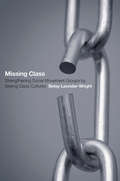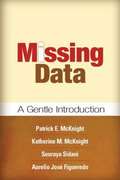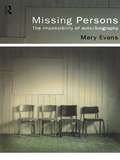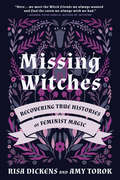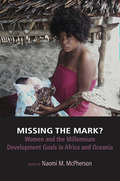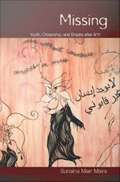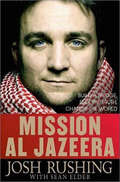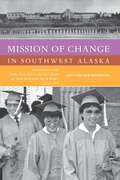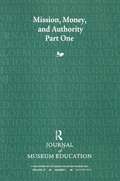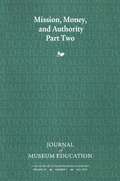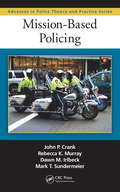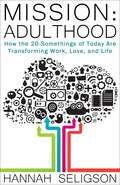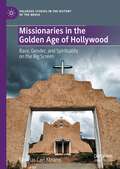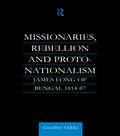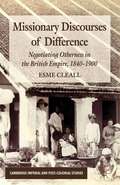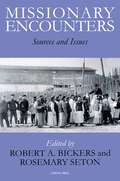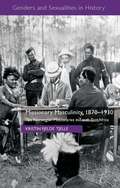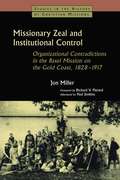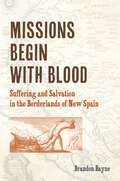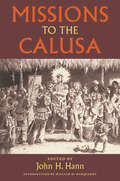- Table View
- List View
Missing Class
by Betsy Leondar-WrightMany activists worry about the same few problems in their groups: low turnout, inactive members, conflicting views on racism, overtalking, and offensive violations of group norms. But in searching for solutions to these predictable and intractable troubles, progressive social movement groups overlook class culture differences. In Missing Class, Betsy Leondar-Wright uses a class-focused lens to show that members with different class life experiences tend to approach these problems differently. This perspective enables readers to envision new solutions that draw on the strengths of all class cultures to form the basis of stronger cross-class and multiracial movements. The first comprehensive empirical study of US activist class cultures, Missing Class looks at class dynamics in 25 groups that span the gamut of social movement organizations in the United States today, including the labor movement, grassroots community organizing, and groups working on global causes in the anarchist and progressive traditions. Leondar-Wright applies Pierre Bourdieu's theories of cultural capital and habitus to four class trajectories: lifelong working-class and poor; lifelong professional middle class; voluntarily downwardly mobile; and upwardly mobile. Compellingly written for both activists and social scientists, this book describes class differences in paths to activism, attitudes toward leadership, methods of conflict resolution, ways of using language, diversity practices, use of humor, methods of recruiting, and group process preferences. Too often, we miss class. Missing Class makes a persuasive case that seeing class culture differences could enable activists to strengthen their own groups and build more durable cross-class alliances for social justice.
Missing Data
by Patrick Mcknight Katherine McknightWhile most books on missing data focus on applying sophisticated statistical techniques to deal with the problem after it has occurred, this volume provides a methodology for the control and prevention of missing data. In clear, nontechnical language, the authors help the reader understand the different types of missing data and their implications for the reliability, validity, and generalizability of a study's conclusions. They provide practical recommendations for designing studies that decrease the likelihood of missing data, and for addressing this important issue when reporting study results. When statistical remedies are needed--such as deletion procedures, augmentation methods, and single imputation and multiple imputation procedures--the book also explains how to make sound decisions about their use. Patrick E. McKnight's website offers a periodically updated annotated bibliography on missing data and links to other Web resources that address missing data.
Missing Data (Quantitative Applications in the Social Sciences)
by Paul D. AllisonSooner or later anyone who does statistical analysis runs into problems with missing data in which information for some variables is missing for some cases. Why is this a problem? Because most statistical methods presume that every case has information on all the variables to be included in the analysis. Using numerous examples and practical tips, this book offers a nontechnical explanation of the standard methods for missing data (such as listwise or casewise deletion) as well as two newer (and, better) methods, maximum likelihood and multiple imputation. Anyone who has been relying on ad-hoc methods that are statistically inefficient or biased will find this book a welcome and accessible solution to their problems with handling missing data.
Missing Data (Quantitative Applications in the Social Sciences)
by Paul D. AllisonSooner or later anyone who does statistical analysis runs into problems with missing data in which information for some variables is missing for some cases. Why is this a problem? Because most statistical methods presume that every case has information on all the variables to be included in the analysis. Using numerous examples and practical tips, this book offers a nontechnical explanation of the standard methods for missing data (such as listwise or casewise deletion) as well as two newer (and, better) methods, maximum likelihood and multiple imputation. Anyone who has been relying on ad-hoc methods that are statistically inefficient or biased will find this book a welcome and accessible solution to their problems with handling missing data.
Missing Persons: The Impossibility of Auto/Biography
by Mary EvansAuto/biography is currently one of the most popular literary genres, widely supposed to illuminate the study of the individual and his or her personal circumstances. Missing Persons suggests that auto/biography is, in fact, based on fictions, both about the person and about what it is possible to know about any one individual.Organised into chapters which consider particular kinds of auto/biographical writing, such as work on the British Royal Family and auto/biographies of twentieth-century men, this book demonstrates the absences and evasions - indeed the `missing persons - of auto/biography. Mary Evans' book will provide invaluable reading for students of womens studies, sociology and cultural studies courses.
Missing Witches: Recovering True Histories of Feminist Magic
by Risa Dickens Amy TorokA guide to invocations, rituals, and histories at the intersection of magic and feminism, as informed by history's witches--and the sociopolitical culture that gave rise to them.When you start looking for witches, you find them everywhere. As seekers and practitioners reclaim and restore magic to its rightful place among powerful forces for social, personal, and political transformation, more people than ever are claiming the identity of "Witch." But our knowledge of witchcraft and magic has been marred by erasure, sensationalism, and sterilization, the true stories of history's witches left untold.Through meditations, stories, and practices, authors Risa Dickens and Amy Torok offer an intersectional, contemporary lens for uncovering and reconnecting with feminist witch history. Sharing traditions from all over the world--from Harlem to Haiti, Oaxaca to Mesopotamia--Missing Witches introduces readers to figures like Monica Sjoo, HP Blavatsky, Maria Sabina, and Enheduanna, shedding light on their work and the cultural and sociopolitical contexts that shaped it. Structured around the 8 sabbats of the Wheel of the Year, each chapter includes illustrations by Amy Torok, as well as invocations, rituals, and offerings that incorporate the authors' own wisdom, histories, and journeys of trauma, loss, and empowerment. Missing Witches offers an inside look at the vital stories of women who have practiced--and lived--magic.
Missing from the Village.: The Story of Serial Killer Bruce McArthur, the Search for Justice, and the System That Failed Toronto's Queer Community
by Justin LingThe tragic and resonant story of the disappearance of eight men--the victims of serial killer Bruce McArthur--from Toronto's queer community.In 2013, the Toronto Police Service announced that the disappearances of three men--Skandaraj Navaratnam, Abdulbasir Faizi, and Majeed Kayhan--from Toronto's gay village were, perhaps, linked. When the leads ran dry, the investigation was shut down, on paper classified as "open but suspended." By 2015, investigative journalist Justin Ling had begun to retrace investigators' steps, convinced there was evidence of a serial killer. Meanwhile, more men would go missing, and police would continue to deny that there was a threat to the community. On January 18, 2018, Bruce McArthur, a landscaper, would be arrested on suspicion of first-degree murder. In February 2019, he was sentenced to life in prison for the murders of eight men. This extraordinary book tells the complete story of the McArthur murders. Based on more than five years of in-depth reporting, this is also a story of police failure, of how the queer community responded, and the story of the eight men who went missing and the lives they left behind. In telling that story, Justin Ling uncovers the latent homophobia and racism that kept this case unsolved and unseen. This gripping book reveals how police agencies across the country fail to treat missing persons cases seriously, and how policies and laws, written at every level of government, pushed McArthur's victims out of the light and into the shadows.
Missing the Mark? Women and the Millennium Development Goals in Africa and Oceania
by Naomi M. McPhersonIn the year 2000, United Nations world leaders set out eight targets, the UN Millennium Development Goals, for achieving improved standards of living at the micro level in poorer nations around the globe, by the year 2015. The papers in this collection present fine-detailed ethnographic studies of cultures in Africa and Oceania, with a focus primarily on MDG 3, targeted to “promote gender equality and empower women” and MDG 5, targeted to “improve maternal health” to ascertain whether or not these goals have made or missed their mark. Ethnographic case studies located in Solomon Islands, Marshall Islands, Federated States of Micronesia, Papua New Guinea, Vanuatu, Ghana, Malawi, Cameroon, and South Ethiopia show that women in these cultures, regardless of nation state, face the same issues or problems—lack of empowerment, gender inequities, and inadequate access to cultural or state resources—to realize good health in general and good maternal and reproductive health, in particular.
Missing: Youth, Citizenship, and Empire After 9/11
by Sunaina Marr MairaIn Missing, Sunaina Marr Maira explores how young South Asian Muslim immigrants living in the United States experienced and understood national belonging (or exclusion) at a particular moment in the history of U. S. imperialism: in the years immediately following September 11, 2001. Drawing on ethnographic research in a New England high school, Maira investigates the cultural dimensions of citizenship for South Asian Muslim students and their relationship to the state in the everyday contexts of education, labor, leisure, dissent, betrayal, and loss. The narratives of the mostly working-class youth she focuses on demonstrate how cultural citizenship is produced in school, at home, at work, and in popular culture. Maira examines how young South Asian Muslims made sense of the political and historical forces shaping their lives and developed their own forms of political critique and modes of dissent, which she links both to their experiences following September 11, 2001, and to a longer history of regimes of surveillance and repression in the United States. Bringing grounded ethnographic analysis to the critique of U. S. empire, Maira teases out the ways that imperial power affects the everyday lives of young immigrants in the United States. She illuminates the paradoxes of national belonging, exclusion, alienation, and political expression facing a generation of Muslim youth coming of age at this particular moment. She also sheds new light on larger questions about civil rights, globalization, and U. S. foreign policy. Maira demonstrates that a particular subjectivity, the "imperial feeling" of the present historical moment, is linked not just to issues of war and terrorism but also to migration and work, popular culture and global media, family and belonging.
Mission Al Jazeera
by Sean Elder Josh RushingBlending his riveting personal story with innovative ideas about how to win the war on terror, former marine turned Al Jazeera reporter Josh Rushing addresses all the issues he was not allowed to talk about when he was in uniform. If we are to win the war on terror, Rushing explains, we have to interact with the media at home and abroad in order to control the way we are perceived. By refusing to appear on Al Jazeera, Western leaders allow people who disagree with the current administration to represent the West to the Arab world in a skewed, negative way. By taking readers inside Al Jazeera, Rushing offers a unique behind-the-scenes look at the controversial news channel and shows how the West can harness it to its advantage, relay a positive message to the Arab public, and hear what it has to say in return.
Mission and Tamil Society: Social and Religious Change in South India (1840-1900)
by Henriette BuggeLooks to provide an analysis of religion as a dynamic factor in Indian society. Not only is the ritual, economic and power status of the missionaries examined but also such effects on their converts as social status and mobility.
Mission from Cape Coast Castle to Ashantee (1819): With A Descriptive Account Of That Kingdom (classic Reprint)
by T.E. BowdichFirst Published in 1966. Routledge is an imprint of Taylor & Francis, an informa company.
Mission of Change in Southwest Alaska: Conversations with Father René Astruc and Paul Dixon on Their Work with Yup’ik People
by Ann Fienup-RiordanMission of Change is an oral history describing various types of change—political, social, cultural, and religious—as seen through the eyes of Father Astruc and Paul Dixon, non-Natives who dedicated their lives to working with the Yup’ik people. Their stories are framed by the an analytic history of regional changes, together with current anthropological theory on the nature of cultural change and the formation of cultural identity. The book presents a subtle and emotionally moving account of the region and the roles of two men, both of whom view issues from a Catholic perspective yet are closely attuned to and involved with changes in the Yup’ik community.
Mission, Money, and Authority, Part One: Journal of Museum Education 35:2 Thematic Issue
by Tina R. NolanSponsored by the Museum Education Roundtable, this is volume 35, Number 2 of the Journal of Museum Education (JME) Part One of Mission, Money, and Authority, published in the summer of 2010. This edition includes articles on museums and other non-profits in the current recession; project fundraising; managing museum priorities in a difficulty economy; obtaining support and reducing obstacles; the value of online learning and making programs self-sustaining.
Mission, Money, and Authority, Part Two: Journal of Museum Education 35:3 Thematic Issue (Journal of Museum Education)
by Tina R. NolanSponsored by the Museum Education Roundtable, this is volume 35, Number 3 of the Journal of Museum Education (JME) Part Two of Mission, Money, and Authority, published in the fall of 2010. This edition includes articles on insistent questions in our learning age, the museum’s economic footprint, putting art into work revenue, when education meets admissions, generating museum education programs for knowledge and three case studies on money and the mission.
Mission-Based Policing (Advances in Police Theory and Practice)
by John P. Crank Dawn M. Irlbeck Rebecca K. Murray Mark SundermeierThe research revolution in police work has uncovered a multitude of data, but this contemporary knowledge has done very little to change the way things are done in most police departments across the U.S., where the prevalent form of policing is based on the traditional model of district assignments and random preventive patrol. Drawn from the work of scholars on the cutting edge of police research, this volume argues for a radical shift in the way policing is approached. It provides concrete recommendations for the fundamental reorganization of the policing institution and presents a comprehensive planning regimen for urban problems that encompasses security, urban reinvestment, and public planning.
Mission: How the 20-Somethings of Today Are Transforming Work, Love, and Life
by Hannah SeligsonGen Y has been picked apart by analysts, statistics, and trend reports, which often portray 20-somethings in negative, one-dimensional terms like "entitled" and "whiners". In this thought-provoking new book that aims to dispel these stereotypes, journalist Hannah Seligson chronicles the lives of seven individuals who embody this generation, exploring their challenges and ambitions in vivid detail and sketching a picture, through their eyes, of what life is actually like for young adults. Through these first-hand stories, readers will discover the transformational effect this enterprising, open-minded, innovative, and diverse generation is having on society."Zeitgeist reporter Hannah Seligson details this new path to adulthood in a book that promises to be illuminating, surprising, and provocative— both for Gen Y readers themselves and for people who want to understand this charming yet sometimes infuriating generation. I need this book. What is "nexting" and "jacked"? —Gretchen Rubin, New York Times Bestselling Author of THE HAPPINESS PROJECT and HAPPIER AT HOME
Missionaries in the Golden Age of Hollywood: Race, Gender, and Spirituality on the Big Screen (Palgrave Studies in the History of the Media)
by Douglas Carl AbramsThis book examines major British and American missionary films during the Golden Age of Hollywood to explore the significance of race, gender, and spirituality in relation to the lives of the missionaries portrayed in film during the middle third of the twentieth century. Film both influences and reflects culture, and racial, gender, and religious identities are some of the most debated issues globally today. In the movies explored in this book, missionary interactions with various people groups reflect the historical changes which took place during this time.
Missionaries, Rebellion and Proto-Nationalism: James Long of Bengal
by Geoffrey A. OddieThe Rev. James Long was one of the most remarkable Protestant missionaries working in India in the nineteenth century. Sent to Calcutta at the age of 22 in 1840, he devoted his life to representing what he passionately believed were the best interests of the forgotten poor and oppressed among the Bengali population. Long was a central figure in the indigo planting controversy of 1861 and suffered imprisonment as a result. His memory is revered even today in modern India, where his contribution to the development of Bengali vernacular education, literature, history, and sociology is highly regarded. Dr Oddie has produced the first full-length biography of Rev Long, examining his work and activities in the context of his own background, philosophy and motivation as well as the political and cultural climate of the day. This book will add significantly to our knowledge of social movements in nineteenth century India and the colonial responses to them.
Missionary Discourses of Difference
by Esme CleallMissionary Discourse examines missionary writings from India and southern Africa to explore colonial discourses about race, religion, gender and culture. The book is organised around three themes: family, sickness and violence, which were key areas of missionary concern, and important axes around which colonial difference was forged.
Missionary Encounters: Sources And Issues
by Robert A. Bickers Rosemary SetonDescribes the exceptional wealth of missionary archives and the major contributions they can make not only to the study of the processes of Christian evangelism and Western imperialism but also their value in documenting and analysing the nature of Western encounters with indigenous societies.
Missionary Masculinity, 1870–1930
by Kristin Fjelde TjelleWhat kind of men were missionaries? What kind of masculinity did they represent, in ideology as well as in practice? Presupposing masculinity to be a cluster of cultural ideas and social practices that change over time and space, and not a stable entity with a natural, inherent meaning, Kristin Fjelde Tjelle seeks to answer such questions.
Missionary Zeal and Institutional Control: Organizational Contradictions in the Basel Mission on the Gold Coast 1828-1917 (Studies In The History Of Christian Missions)
by Jon MillerThis book is about the Basel Mission in the Gold Coast (now Ghana) before the First World War. Miller reconstructs the backgrounds and motivations of the mission's participants and describes the organizational structure that shaped their activities at home and abroad. He then traces some serious and recurrent internal problems to the commitment to difficult Pietist beliefs about authority and obedience. The organization survived those troubles and its impact on Ghana continued to grow, because the same biblical worldview that demanded extreme discipline also prepared the members of the mission community to sustain their efforts.
Missions Begin with Blood: Suffering and Salvation in the Borderlands of New Spain (Catholic Practice in North America)
by Brandon BayneWinner, 2022 Frank S. and Elizabeth D. Brewer PrizeWhile the idea that successful missions needed Indigenous revolts and missionary deaths seems counterintuitive, this book illustrates how it became a central logic of frontier colonization in Spanish North America. Missions Begin with Blood argues that martyrdom acted as a ceremony of possession that helped Jesuits understand violence, disease, and death as ways that God inevitably worked to advance Christendom. Whether petitioning superiors for support, preparing to extirpate Native “idolatries,” or protecting their conversions from critics, Jesuits found power in their persecution and victory in their victimization. This book correlates these tales of sacrifice to deep genealogies of redemptive death in Catholic discourse and explains how martyrological idioms worked to rationalize early modern colonialism. Specifically, missionaries invoked an agricultural metaphor that reconfigured suffering into seed that, when watered by sweat and blood, would one day bring a rich harvest of Indigenous Christianity.
Missions to the Calusa (Florida Museum of Natural History: Ripley P. Bullen Series)
by John H. HannA compilation of historical documents written by Europeans during the colonization of southwest FloridaWhen Europeans arrived in southwest Florida in the early sixteenth century, they encountered a complex and powerful society. The Calusa have posed an enigma to many anthropologists and historians. This work provides missing information on the ethnography of the Calusa, a society that inhabited the area of Florida now known as Charlotte, Lee, and Collier counties. This compilation of historical documents includes many reports never before translated into English, including letters from Pedro Menéndez, reports from King Charles II and governors, bishops, and soldiers, and eyewitness testimony from priests and laypersons about mission efforts from the sixteenth through the eighteenth centuries.John Hann introduces Spanish contact with the Calusa from the early seventeenth century, focusing particularly on the ill-fated Franciscan attempt in 1697 to convert the Calusa to Christianity. His voluminous documentation for this effort is particularly valuable for its description of the role played by the Crown in instigating the mission despite little enthusiasm from religious authorities.A volume in the Florida Museum of Natural History: Ripley P. Bullen Series
